.
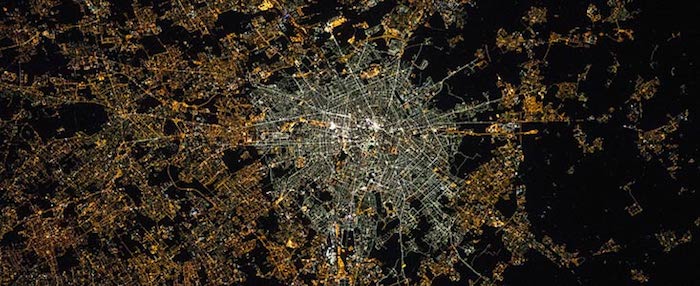
Scientists are tapping into photographs taken by astronauts aboard the International Space Station (ISS) to reliably measure the amount of light pollution worldwide. This study not only includes the well-known signatures of cities and streets, but also the effects of faint indirectly scattered light, which up to now had not been measured quantitatively. The new results confirm that this diffuse glow, which is seen from space, is scattered light from streetlights and buildings. This is the component responsible for the brightening of the night skies in and around cities, which drastically limits the visibility of faint stars and the Milky Way. The team also concludes that European countries and cities with a higher public debt also have higher energy consumption for street lighting per inhabitant, and that the total cost of the energy consumption for street lights is 6300 million euros/year in the European Union. The findings were presented today at the IAU XXIX General Assembly in Honolulu, Hawaii.
In a remarkable new study, scientists from the Universidad Complutense de Madrid, Spain and the Cégep de Sherbrooke in Canada, together with members of the public, have worked on a project called Cities at Night. The aim is to produce a global colour map of the Earth [1] at night from pictures taken by astronauts on the International Space Station using a standard digital camera.
Starting in July 2014, this huge project required the cataloging of over 130 000 images — the ISS’s entire high-resolution archive — and geo-referencing them to place them on a map. The images were also calibrated using the stars in the background sky over the ISS, as well as ground-based measurements of the night sky brightness [2].
Previously, light pollution measurements had to be done in situ and would contribute only a single measurement to the light pollution map. This new method, connecting space-based measurements of light pollution with ground-based night sky brightness measurements, makes it possible, for the first time, to map light pollution reliably over extended areas.
A diffuse light present around cities, in addition to the familiar bright lights from streets and factories, was previously detected by the Defense Meteorological Satellite Program, but its nature remained unknown; the satellite’s low-resolution cameras could not distinguish it from other instrumental factors. However, the high-resolution images captured by the astronauts — in addition to an extensive sky brightness survey conducted around Madrid — have now allowed scientists to observe the direct relationship between the diffuse light observed and light pollution from artificial lights.
Using the ISS astronaut images, as well as data from the Defense Meteorological Satellite Program and the Suomi National Polar-orbiting Partnership Satellite, the researchers also discovered that European countries and cities that have a higher public debt [3] also have a higher energy consumption of street lighting per inhabitant. The total cost of the energy consumption for streetlights is estimated by the study to be 6300 million euros/year in the European Union. The different ways of calculating streetlight energy costs across Europe previously made such an estimate impossible.
This citizen science project is vital for researchers from many scientific fields. Studying lighting technology from orbit is currently of even greater importance now than before due to massive transitions to LED technology [4]. The ISS is the only place from which it is possible to estimate the prevalence of the different types of lighting technologies used in cities around the world and to measure the impact of light pollution on the environment and human health.
“Until the advent of new satellites, astronaut photography was our only colour and high-resolution window on the Earth,” says lead scientist Alejandro Sánchez de Miguel.
After gaining the initial support of multiple institutions [5] and thousands of volunteers, the next phase of the Cities at Night project aims to gather funding to keep the project running, so it can extend its colour map of the nightside of the Earth.
Notes
[1] So far only a part of the Earth has been covered by astronaut photos, and only a fraction of the astronaut photos have been geo-referenced.
[2] Only RAW images can be used for scientific photometry after taking into account the instrumental effects of the digital SLR camera used.
[3] The General government gross debt for 2014 was used, as calculated by EuroStat.
[4] LED streetlights have been installed or announced for installation in several large cities as well as smaller cities throughout the world. LED street lights make light pollution — such as sky glow — significantly worse, as they emit more blue and green light than the high-pressure sodium lights that they typically replace.
[5] NASA, ESA and the Canadian Space Agency (CSA) helped by giving the project visibility, while Google Outreach and Cartodb helped with the visualisation of the products. MediaLab-Prado assisted with the design of the web pages and Crowdcrafting/Scifabrik supported the hosting of the citizen science programme. Kickstarter and the Sociedad Española de Astronomía helped to organise transport to conferences to present the results, and the Universidad Complutense de Madrid and the Cégep de Sherbrooke hosted the researchers.
.
Milan seen from the ISS in 2015
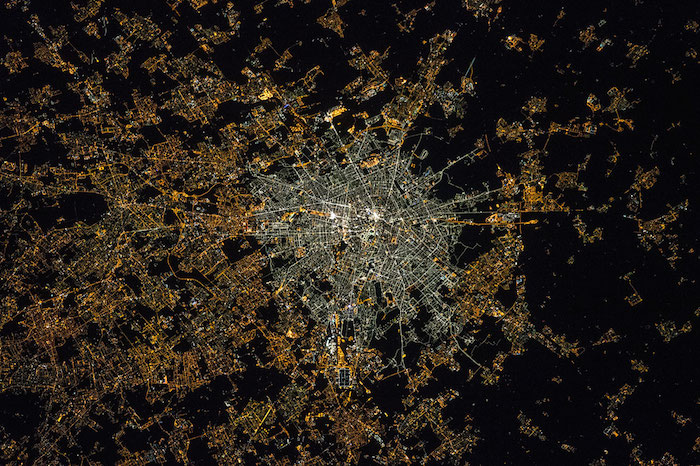
This image of Milan was acquired after the transition to LED technology in the centre. The illumination levels appear to be similar or even brighter in the centre than the suburbs, and the amount of blue light is now much higher, which suggests a greater impact on the ability to see the stars, human health and the environment.
.
Milan from the ISS in 2012
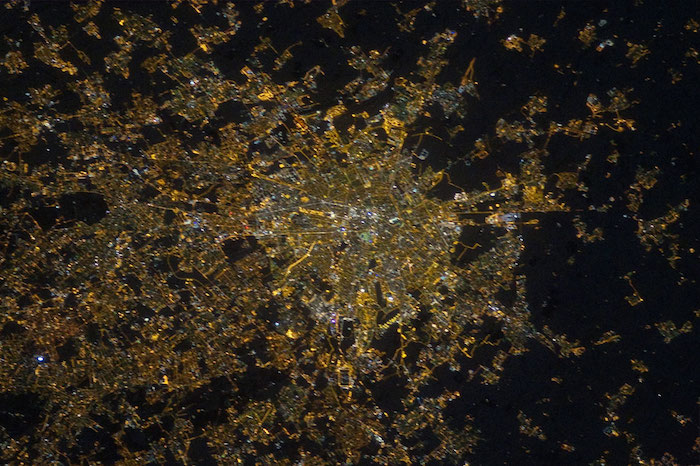
Image of Milan before the transition to LED technology. The many different streetlight colours visible indicate the use of different lighting technologies. The illumination level of Milan centre is similar to its suburbs.
This image was taken by André Kuipers.
.
Image of La Palma island
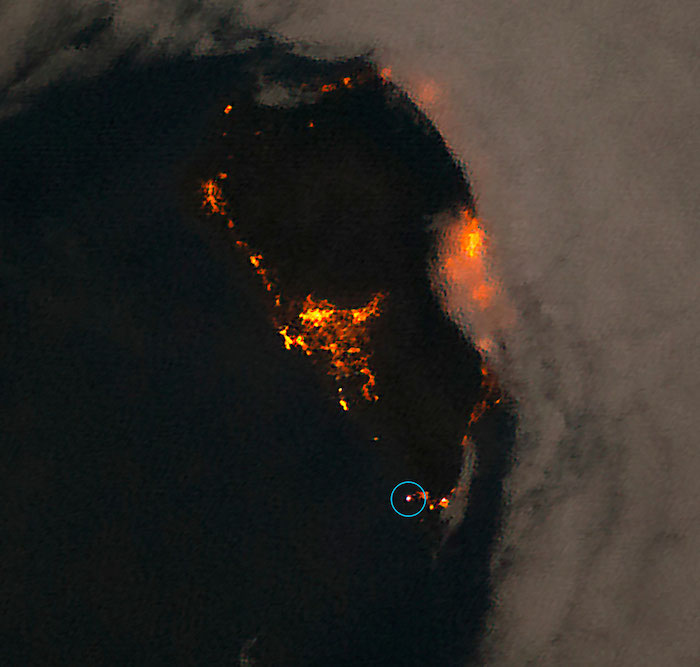
The image shows the potential of using ISS images to detect lighting installations that are not allowed near observatories. On the island of La Palma, the use of white light is forbidden by observatory protection laws. One candidate violation can be spotted on this image and is marked with a green circle.
.
Small part of the new light pollution map

An example of the differences between countries seen from the ISS. Belgium uses mainly orange lighting (low pressure sodium lamps) and illuminates all its highways, The Netherlands illuminates only a few highways. Germany does not light its highways and has much lower illumination levels. Google outreach contributed to the project.
.
Direct and indirect light pollution around Madrid
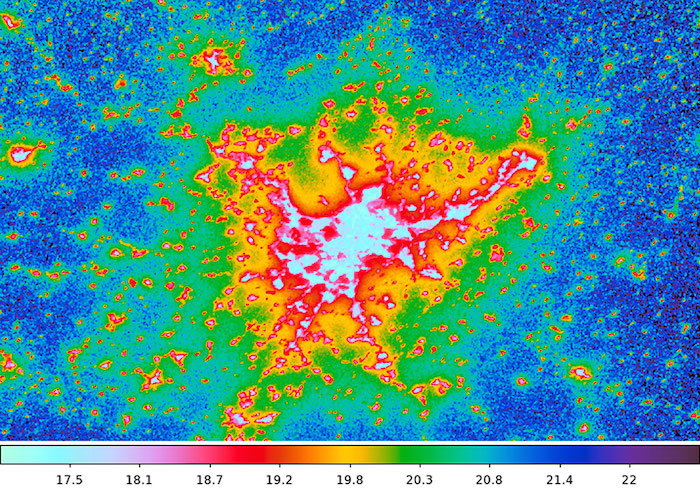
This map shows the zenith sky brightness around Madrid in Spain, based on ISS images. The white areas indicate direct light from streetlights and the diffuse light component corresponds to other colours, confirmed from the ground. The units are magnitudes/arcsec2.
The image was taken by Alexander Gerst with European Space Agency’s NightPod device which compensates for the station’s speed and the motion of the Earth below.
Quelle: IAU, Universidad Complutense de Madrid and the Cégep de Sherbrooke
4901 Views
